December 2025
The global artificial intelligence in chemicals market size was valued at USD 2.19 billion in 2024 and is expected to reach around USD 28.74 billion by 2034, growing at a CAGR of 29.36% from 2025 to 2034. The growing demand for sustainable & innovative products and the rising demand for operational efficiency drive the growth of the market.

AI in chemicals is a method for optimizing various aspects of chemical processes, like supply chain management, research & development, and manufacturing. AI helps in research & development, various processes like molecular modelling & design, reaction optimization, and virtual screening. AI helps in predicting chemical manufacturing equipment failures and easily identifies inefficiencies in the production processes. It can easily detect variations in product quality and produce high-quality output. AI schedules repairs of equipment and predicts the need for maintenance of chemical manufacturing equipment. AI maintains quality assurance in the production of the chemicals and easily detects the wrong substance in the product line.
AI in chemical enhances manufacturing productivity and increases cost-effectiveness. It automatically controls conditions like process duration, stirring rate, and temperature. AI helps to maintain environmental sustainability and creates environmentally friendly products. AI in chemicals helps in predictive maintenance, safety & risk management, and environmental monitoring. The growing research and development of new chemical formulations help in the market growth. The growing demand for enhancing quality control in the production process of chemicals increases the demand for AI. Factors like growing demand for process optimization, growing focus on sustainability, increasing demand for enhanced supply chains, smart manufacturing of chemicals, and growing demand for cost reduction contribute to the AI in chemicals market.
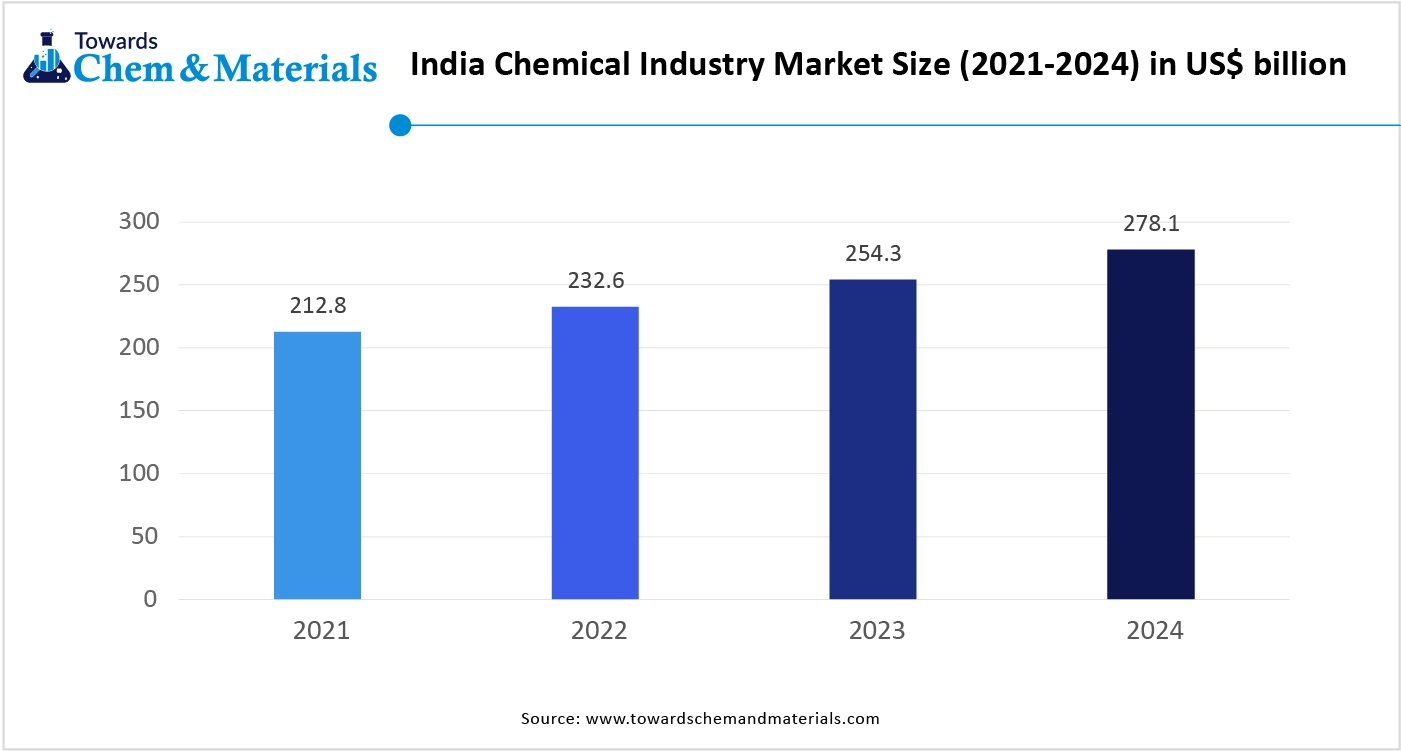
The growing digital transformation in the chemical industry increases the adoption of AI. It helps chemical companies to leverage, collect, and analyze a large amount of data to improve sustainability, enhance operations, and accelerate innovations. Digital transformation collects data from sources like digital twins, sensors, and IoT devices and improves chemical product quality, predicts equipment failures, and optimizes resource utilization. It helps to lower manual effort and automate routine tasks in the chemical industry. It supports research & development, inventory management, and production scheduling of the chemical industry.
It detects potential equipment failures and lowers maintenance costs. Digital transformation allows chemical companies to reduce disruptions, manage equipment, and ensure reliable operation. The growing awareness about environmental issues increases the demand for lowering the environmental footprint and minimizing waste from chemical processes. Digital transformation supports the rapid development of innovative products and solutions in the chemical industry. The growing digital transformation is a key driver for AI in chemicals market.
| Report Attributes | Details |
| Market Size in 2025 | USD 2.83 Billion |
| Market Size by 2034 | USD 28.74 Billion |
| Growth Rate from 2025 to 2034 | CAGR 29.36% |
| Base Year of Estimation | 2024 |
| Forecast Period | 2025 - 2034 |
| High Impact Region | North Ameica |
| Segment Covered | By Type, By Application, By End Use, By Region |
| Key Companies Profiled | BASF SE, IBM Corporation, Accenture, Google LLC, Honeywell International Inc., Insilico Medicine, NVIDIA CORPORATION, Microsoft, Siemens , SLB |
The growing environmental concerns increase the adoption of sustainable practices in the chemical industry, fueling demand for AI. Artificial intelligence helps in preventing waste and identifies inefficient materials before use. It minimizes waste, predicts potential issues, improves process efficiency, and optimizes the consumption of energy. AI accelerates the discovery of chemical formulations, catalysts, and materials. AI helps in searching molecules, which reduces environmental impact. It helps in designing new processes to lower energy consumption and minimize byproducts. AI supports recycling processes and improves waste management strategies. AI-powered technologies like digital twins accelerate manufacturing processes and allow testing before implementation. AI helps in lowering carbon footprints and enables companies to track emissions. The growing focus on sustainable manufacturing creates an opportunity for AI in chemicals market.
Despite several benefits of AI in chemicals, the high initial investment restricts the growth of the market. The requirement of advanced infrastructure like networking & data storage, hardware like IoT sensors, and software like data management tools increases the overall costs. The requirement of trained professionals in the chemicals and AI industry increases the cost. The cost of integrating of AI system with existing processes is high. The requirement of upgrading infrastructure and the need for significant resources increase the initial investment. The cost of managing, acquiring, and cleaning high-quality datasets is high. The uncertainty in ROI at the initial stages of AI development increases the overall cost. The high initial investment hampers the growth of AI in chemicals market.
North America Powerhouse of AI in Chemicals Market
The North America AI in chemicals market size is calculated at USD 0.93 billion in 2024 and is projected to grow around USD 12.26 billion by 2034 with a CAGR of 29.42%. North America dominated the AI in chemicals market in 2024. The presence of advanced technological infrastructure, like access to skilled labor, computing power, and data storage, increases demand for AI in chemicals. The extensive private & public investment in AI research & development helps in the market growth. The strong presence of major chemical manufacturing companies to develop new products, improve efficiency, and optimize processes increases demand for AI solutions. The stricter environmental regulations increase the adoption of AI to help chemical companies comply with regulations, lower waste, and enhance resource utilization. The strong government support for digital transformation and AI research & development supports the overall growth of the market.
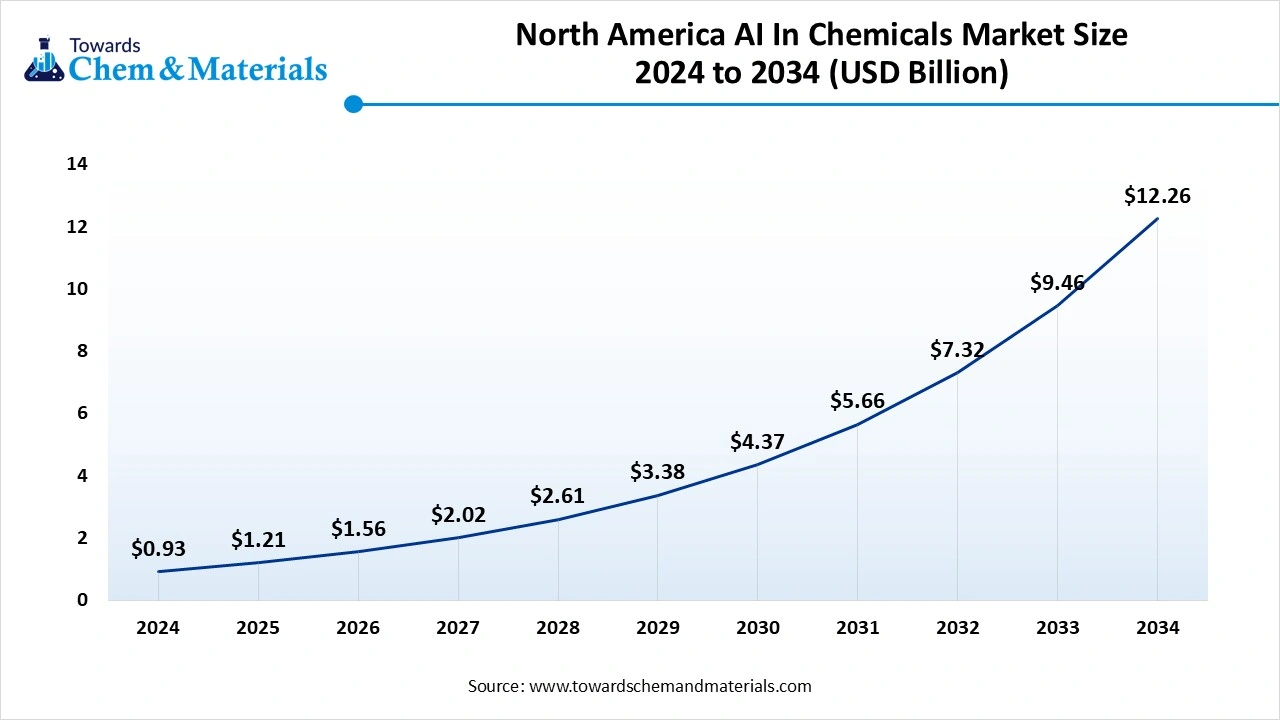
What are the Trends Of AI In Chemicals in the United States?
The United States is a major contributor to market. The extensive private sector and government investment in AI research & development increases the adoption of AI in the chemical industry. The supportive regulatory framework and growing awareness of digitalization help in the market growth. The growing demand for predictive maintenance and process optimization increases the adoption of AI in chemicals. The presence of the major chemical companies and the growing demand for sustainability drive the overall growth of the market.
Why is Asia Pacific Growing in the AI in Chemicals Market?
Asia Pacific is growing at the fastest CAGR in the market during the forecast period. The growing demand for chemicals and the presence of a well-established chemical industry increase the demand for the AI solution. The growing demand for innovation in the chemical industry and improving efficiency help in the market growth. The strong investment in smart manufacturing systems to minimize cost, optimize production processes, and improve quality control fuels demand for AI in chemicals. The supportive government policies for innovation and promoting digitalization increase the adoption of AI in chemicals. The growing population increases demand for various chemical products like specialty chemicals, plastics, and fertilizers helps in the market growth. The growing consumption & production of chemicals in countries like Japan, China, and India support the overall growth of the market.
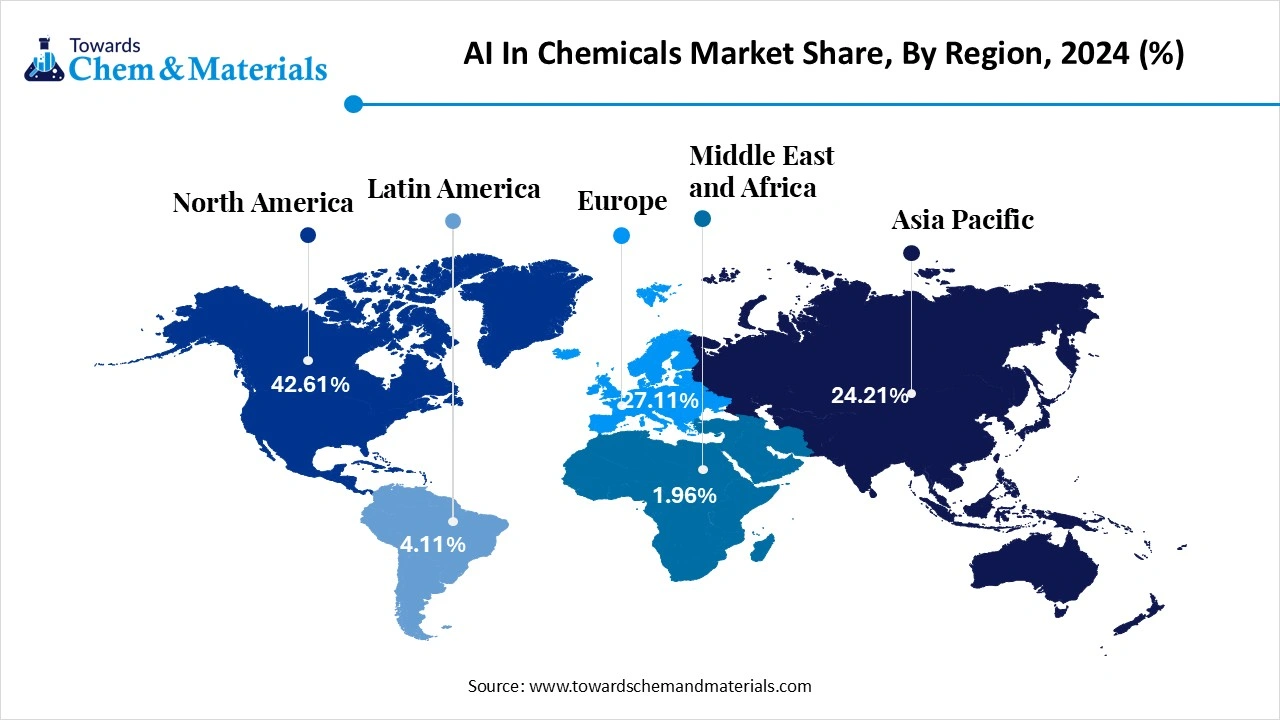
China’s AI in Chemicals Market Trends
China is a key contributor to the AI in chemicals market. The presence of a large chemical industry and growing chemical production increases demand for AI solutions. The strong government support for AI research & development in industries like chemicals helps in the market growth. The strong share in consumer chemicals and fine chemicals increases the adoption of AI in chemicals. The strong AI ecosystem and large-scale chemical production support the overall growth of the market.
Why Did Software Segment Dominate AI in Chemicals Market in 2024?
The software segment dominated AI in chemicals market in 2024. The growing demand for process automation and predictive analytics increases the demand for software solutions. The growing demand for managing laboratory operations, optimizing chemical reactions, and predicting material properties helps in the market growth. The growing adoption of advanced technologies like advanced analytics, machine learning, and deep learning increases demand for the software in the chemical industry. The growing demand for cloud-based solutions helps in the market growth. The growing integration of software with advanced technologies like cloud computing, IoT, and big data analytics supports the overall growth of the market.
The services segment is experiencing the fastest growth in the market during the forecast period. The growing demand for AI-powered predictive maintenance is to lower maintenance costs, reduce downtime, and extend equipment lifespan increases demand for AI services. The growing demand for customizing processes for optimal performance and expertise in customizing AI models helps in the market growth. The growing demand for support, maintenance, and updates to enhance performance increases demand for the services. The growing consulting and training services for the adoption of AI in the chemical industry drive the market growth. The increasing demand for improving product quality, optimizing resource allocation, and lowering waste increases demand for AI services, contributing to the overall growth of the market.
What Made Production Optimization Dominate the AI in Chemicals Market?
The production optimization led the AI in chemicals market in 2024. The growing demand for failure prevention, quality control, and process improvement helps in the market growth. The increasing demand for enhancing energy efficiency, optimizing resource utilization, and lowering waste increases the demand for production optimization. The growing demand for adjusting and monitoring production parameters in real-time, fuel demand for production optimization. The growing acceleration of research & development and the discovery of new chemicals drive the growth of the market. The growing demand for process improvement, like flow rates, temperature, and pressure, supports the overall growth of the market.
The new material innovation is the fastest growing in the market during the forecast period. The growing analysis of vast amounts of data from simulations & experiments, and the identification of chemical formulations, help in the market growth. The growing analysis of a large number of datasets and the identification of new materials increases demand for AI algorithms. The acceleration in the chemical synthesis process increases production of the new materials. The growing production of eco-friendly materials and the demand for reducing environmental impact contribute to the overall market growth.
How Base Chemicals & Petrochemicals Segment Dominated the AI in Chemicals Market?
The base chemicals & petrochemicals segment dominated the AI in chemicals market in 2024. The growing large-scale production and optimization of base chemicals & petrochemicals help in the market growth. The complex processes and demand for better resource utilization, improving yields & lowering costs increase the adoption of AI in base chemicals & petrochemicals. The growing demand for predictive maintenance of petrochemical refineries and minimizing downtime helps market growth. The chemical plants and petrochemical refineries generate large amounts of data increases the adoption of AI. The growing adoption of sustainable practices in base chemicals and petrochemicals supports the overall growth of the market.
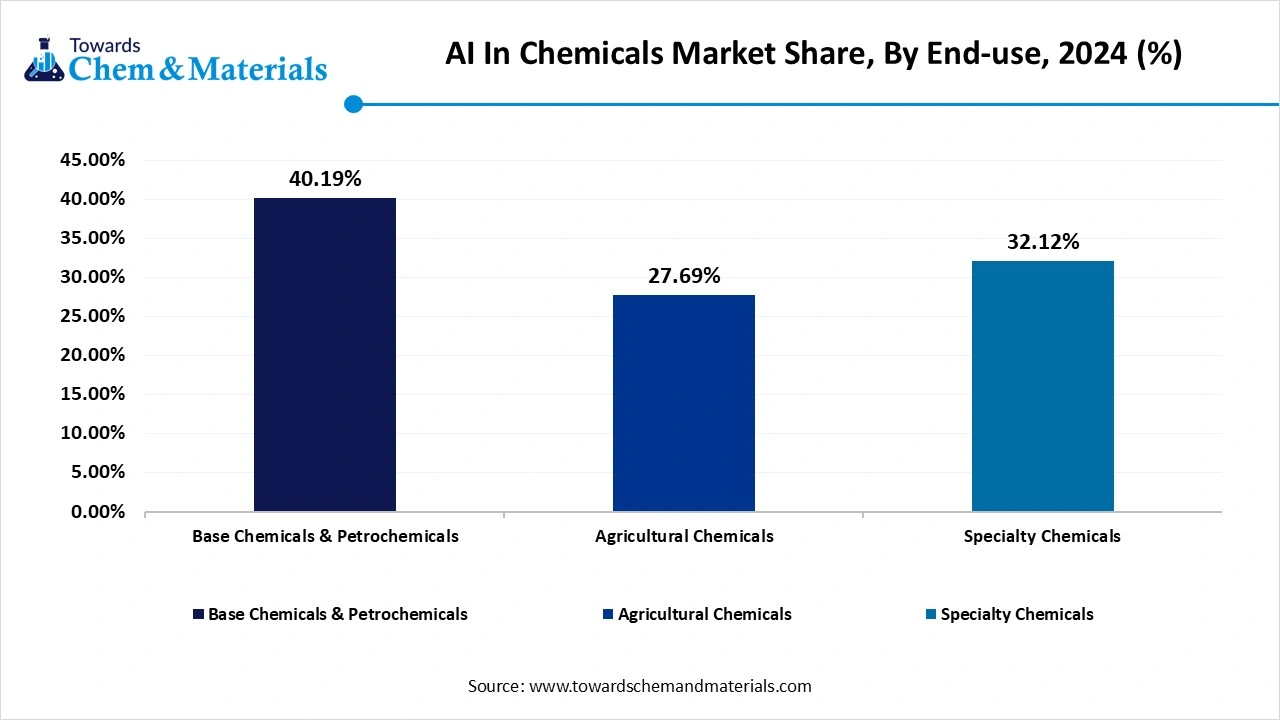
The specialty chemicals segment is the fastest growing in the market during the forecast period. The growing demand for specialty chemicals in various industries like consumer goods, pharmaceuticals, and electronics helps in the market growth. The growing development of High-performance products and materials increases demand for specialty chemicals. The development of new products using specialty chemicals increases the adoption of AI. The growing demand for data-driven decision-making and optimizing processes of specialty chemicals increases the demand for AI. The growing adoption of sustainable practices, including improving resource efficiency & lowering emissions, supports the overall market growth.
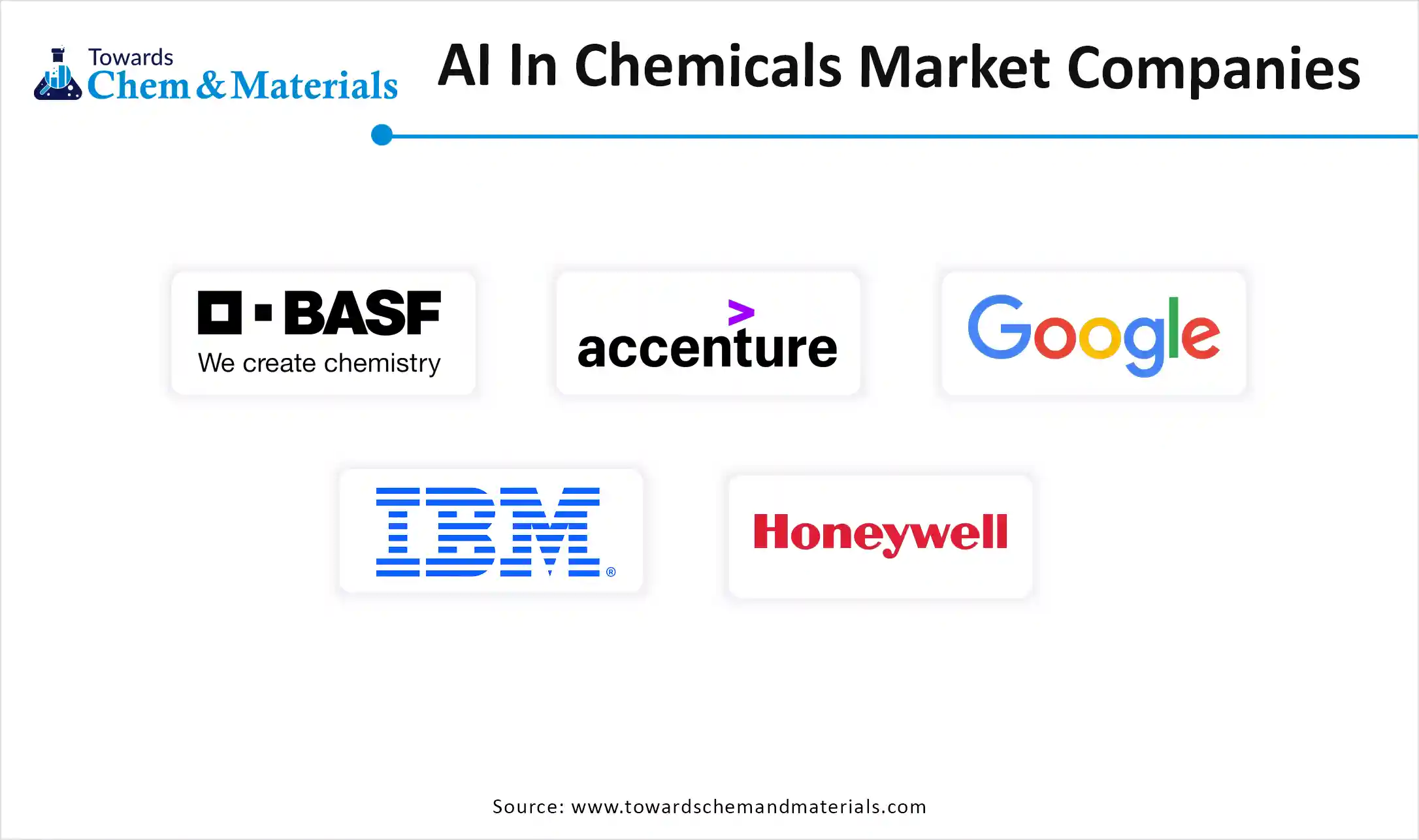
By Type
By Application
By End Use
By Region
December 2025
December 2025
December 2025
December 2025